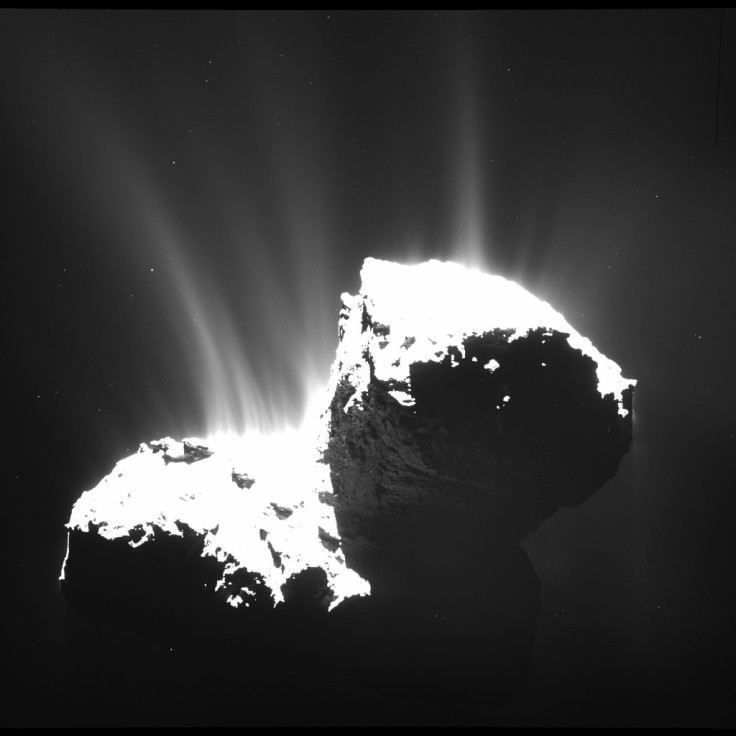Rosetta sniffs nitrogen 'the most wanted molecule' on Comet 67P

Molecules of nitrogen have been detected on a comet for the first time by ESA's Rosetta spacecraft.
The findings by a team led by researchers at the University of Bern followed measurements with the mass spectrometer Rosina on board the Rosetta orbiting comet 67P/Churyumov-Gerasimenko.
Molecular nitrogen, N2, is the major molecule in the atmosphere of Earth and is also present in the atmosphere and surfaces of Pluto and Neptune's moon Triton.
The nitrogen measurements suggest that the comet 67P is formed in a very cold region of our solar system.
The comet hails from the Kuiper Belt region of the solar system, located beyond Neptune's orbit.
Martin Rubin from the Physics Institute at the University of Bern and his team measured this "most wanted molecule", as Rubin calls it, in the coma or the atmosphere of the comet nicknamed Chury.
"Although some comets like Chury were probably formed in the same region as Triton and Pluto, until now we weren't able to find any molecular nitrogen in them," Rubin explains. "Because a comet's water ice can trap only small amounts of it remote sensing as well as in situ analysis were simply not sensitive and precise enough."
Rosina was built at the University of Bern and has the required resolution to distinguish on site molecules with almost identical molecular weights, which is the case for carbon monoxide and molecular nitrogen, Rubin says.
The instrument was designed and built almost 20 years ago.
"The amount of molecular nitrogen brought to Earth by comets such 67P/Churyumov-Gerasimenko is small compared to other nitrogen-bearing molecules like ammonia," says Rosina principal investigator Kathrin Altwegg.
Water and the comets
The latest results add to growing evidence that comets like Chury cannot be a major source of both water and volatiles like nitrogen on Earth.
Altwegg and her team had recently discovered that the ratio of deuterium to hydrogen in the water of the comet differed a lot from that on Earth, indicating different sources.
Three years ago, analysis of water in another Kuiper Belt comet showed matching water chemical fingerprints. But the Rosetta measurements are so high that even a few comets of its type smashing into Earth should have changed the deuterium ratio on ground.
"Like the origin of our water, the missing molecular nitrogen in comets was another open question raised during the Giotto mission to comet 1P/Halley almost 30 years ago," she explains.
Matt Taylor, ESA's Rosetta project scientist, calls the discovery of molecular nitrogen "another piece of the puzzle" in terms of the role Jupiter-family comets played in the evolution of the Solar System.
"But the puzzle is by no means finished yet," he adds. "Rosetta and Chury are about five months away from perihelion now, and we'll be watching how the composition of the gases changes over this period, and trying to decipher what that tells us about the past life of this comet."
The craft arrived at Chury in August 2014 after a ten-year journey through space and has been collecting data on the comet ever since.
Rosetta mission
Launched in March 2004, Rosetta visited Mars, came back to Earth (after briefly being misidentified by astronomers as an asteroid), visited asteroid 2867 Šteins 5 and then was back to Earth again; next it dropped in on asteroid 21 Lutetia, before finally reaching Chury in August last year and dropping a lander on the comet in a feat that was unparalleled in space.
Strange features like goose bumps on the comet's surface arising from outgases from its active northern region was detected by the camera Osiris on Rosetta.
The Virtis instrument meanwhile yielded evidence of carbon based on the surface of the comet's nucleus. More results will follow from Rosetta's observations of the comet.
Earlier, before it was lost the Philae lander had returned exciting evidence of organic molecules on the comet.
Rosetta will remain in orbit around Chury much after its lifetime, tied to the comet by its weak gravitational tug.
Formed around 4.5 billion years ago and frozen ever since, comets preserve traces of the original primordial solar system matter. Studying their nucleus and coma gives vital clues about the conditions in the early solar system.
© Copyright IBTimes 2025. All rights reserved.





















